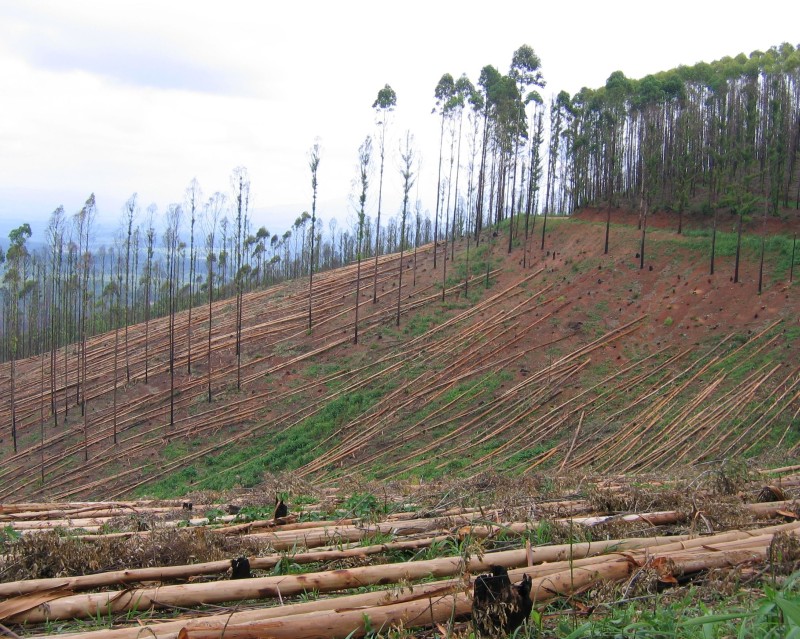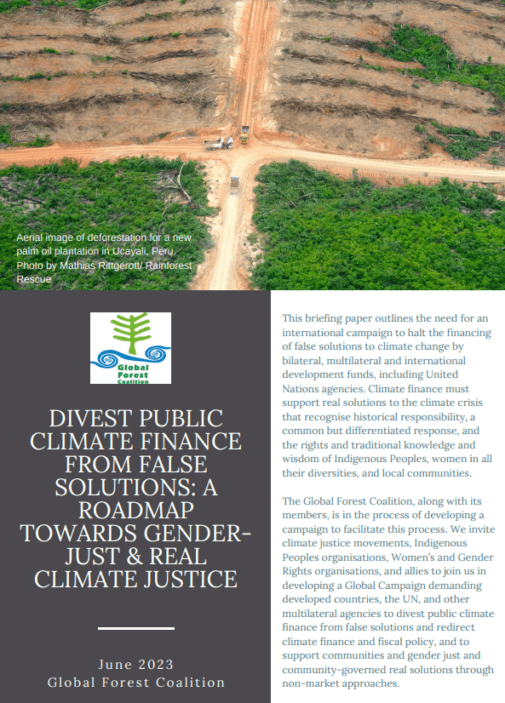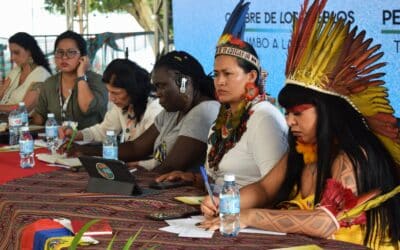Divest Public Climate Finance from False Solutions: A Roadmap Towards Gender-Just & Real Climate Justice
Download the briefer here: A Brief on the Urgent Need to Divest Public Climate Finance from False Solutions
This briefing paper outlines the need for an international campaign to halt the financing of false solutions to climate change by bilateral, multilateral and international development funds, including United Nations agencies. Climate finance must support real solutions to the climate crisis that recognise historical responsibility, a common but differentiated response, and the rights and traditional knowledge and wisdom of Indigenous Peoples, women in all their diversities, and local communities.
The Global Forest Coalition, along with its members, is in the process of developing a campaign to facilitate this process. We invite climate justice movements, Indigenous Peoples organisations, Women’s and Gender Rights organisations, and allies to join us in developing a Global Campaign demanding developed countries, the UN, and other multilateral agencies to divest public climate finance from false solutions and redirect climate finance and fiscal policy, and to support communities and gender just and community-governed real solutions through non-market approaches.
Background
Article 2 (a) of the Paris Agreement aims to strengthen the global response to the threat of climate change by “holding the increase in the global average temperature to well below 2°C above pre-industrial levels and pursuing efforts to limit the temperature increase to 1.5°C above pre-industrial levels.” According to the IPCC Sixth Synthesis Report, continued greenhouse gas emissions will lead to increasing global warming in the near term, which is estimated to reach 1.5°C between 2030-35. Their assessment also indicates that limiting warming to around 1.5°C requires global greenhouse gas emissions to peak before 2025 at the very latest, and be reduced by 43% by 2030.
It is therefore evident that we require real and immediate climate solutions backed by climate finance, technology transfer, and policy and legislative support at all levels, including support for adaptation. The Paris Agreement goals cannot be achieved without an equitable, gender just and rights-based approach to climate justice.
However, the current approach is engineering inequity in climate finance. At a UN climate summit in Copenhagen in 2009, developed countries promised to channel US$100 billion a year for climate action to the Global South by 2020. This promise remains unfulfilled. Moreover, they are steering a false and disastrous discourse of propping up the carbon market through carbon trading and offset projects for climate finance flows. Over the last two decades, developed countries have invested public finance to promote, facilitate and subsidise a range of false solutions such as monoculture plantations, REDD+, and bioenergy from burning forest biomass. Public money is being used to promote Public Private Partnerships (PPPs) and de-risk private finance to leverage funds for climate investment.
As a result, big polluters and corporations have been given a long rope to delay capping their emissions, while false Net Zero commitments and so-called Nature-based Solutions (NbS) gain ground. In this paper, we will see how these methods have led to millions of hectares of forests, community lands, and indigenous territories being subjected to land grabbing, while GHG emissions continue to rise.
Monoculture tree plantations: contributing to deforestation and biodiversity loss
Policymakers and a few big conservation NGOs have been trying to present planting trees such as eucalyptus, acacia, and pines as ‘forest restoration’. But plantations are not forests – plantations are much poorer at storing carbon than natural forests. The regular harvesting and clearing of plantations releases stored CO2 back into the atmosphere.
In contrast, natural forests continue to sequester carbon for many decades. Plantations lock in community lands, destroy livelihoods, lower the water table, and harm biodiversity. Studies carried out in communities that have experienced tree plantation projects over the past decades have documented significant negative social, environmental, and economic impacts. Evidence also shows that these impacts tend to affect women more severely – one major reason for this is that land rights tend to shift from women to men when land becomes commercially attractive through, for instance, plantations and offset projects.
If current restoration plans are enacted, the world’s tropical and subtropical plantation estate would rise by 157 million hectares (Mha), to 237 Mha. This would mark a major shift in global land use. As the Land Gap Report (2022) points out, approximately half of the area pledged for removals, which include plantations (about 633 Mha), requires major land-use change in the form of tree planting to establish new forests, reforestation, or plantations.
The German government and the International Union for Conservation of Nature (IUCN) launched the Bonn Challenge in 2011, with a target of restoring 150 Mha of forest by 2020. This was later revised to 350 Mha by 2030 by the New York Declaration on Forests at the 2014 UN Climate Summit. Under this initiative, 43 countries across the tropics and subtropics have committed nearly 300 Mha of degraded land, of which almost half of the pledged area is set to become plantations of commercial trees.
The Bonn Challenge is estimated to cost about USD 359 billion. The lofty targets of the New York Declaration will require an estimated USD 837 billion. Similar forest landscape restoration initiatives require funding of USD 49 billion per year. WWF has identified four key bilateral donors (France, Germany, Norway, and the United States) and three multilateral donors (the European Union (EU), the Green Climate Fund (GCF), and the Global Environment Facility (GEF)).
AFR100 is an Africa-wide initiative aiming to restore 100 million hectares of degraded forest land by 2030. Launched in 2015 at the Paris Climate Summit as one of four regional initiatives contributing to the Bonn Challenge, pledges from 30 countries have now exceeded the target by more than 25 Mha. The initiative is now hoping to leverage US$100 billion to achieve the targets pledged.
Targets involving commercial plantations that fall within AFR100 pledges add to over 4.5 Mha of commercial tree plantation expansion, and 770,000 hectares of improved plantation management. This is equivalent to a 91% increase in the land area currently occupied by commercial plantations in Africa.
The German government through its Federal Ministry of Economic Cooperation and Development (BMZ) has invested EUR 2 billion in forest-related projects, including the GIZ-implemented Forests4Future program. Forests4Future has so far provided around 4.4 million Euros in support of AFR100, including financing the AFR100 secretariat.
In yet another example of public money being used to de-risk private sector finance for plantations, the Green Climate Fund (GCF), the UN Climate Change Convention’s financing mechanism, has provided approximately $102 million to four projects in Paraguay to date, which includes signing a highly-controversial $25 million equity agreement with a Germany-based private equity investment firm in 2020, the Arbaro Fund, to support its plans to invest in 75,000 hectares of new tree plantations across seven target countries in Latin America and Sub-Saharan Africa. The Arbaro Fund had already mobilised development finance from European Investment Bank and FinnFund (where Finnish State is a majority stakeholder).
REDD+: a public investment that failed to halt deforestation
REDD+ is a highly controversial scheme that has divided governments, civil society, and Indigenous Peoples’ organizations, and proved to be highly contentious within the United Nations itself. Some big conservation groups continue to believe in the power of the market to mitigate climate change, while other civil society actors, particularly Indigenous Peoples’ organizations, view and experience this approach as a facilitator of dispossession and resource extraction, and a false solution to the climate crisis.
REDD+ reduces forests to simple carbon sinks, rather than complex ecosystems, and assumes that calculating the contribution of forests to climate change mitigation is simply a matter of counting the carbon that is stored in the trees in the forest. GFC’s briefing paper on REDD+ found that it commodifies the key components of life that forest peoples depend on, handing control over forests and their use to powerful state and corporate actors.
REDD+ projects require the mobilisation of enormous financial resources. The majority of REDD+-related projects and policies have been supported through direct grants from donor countries or international organizations like the World Bank, the United Nations Development Program (UNDP), the United Nations Environment Programme (UNEP), the UN Food and Agriculture Organisation, the International Fund for Agricultural Development, the GEF, the World Bank, the International Finance Corporation, and the GCF.
Between 2008 and 2015, 87% of Official Development Assistance (ODA) for activities labelled as REDD+ was committed by Norway, Germany, the United Kingdom, the United States, and Australia. Around 25–33% of this funding is channelled via multilateral funds managed by a handful of institutions: the World Bank, the UN-REDD programme, the GEF, and the GCF.
Global estimates show that approximately USD 15 billion per year is required for REDD+. Approximately USD 6 billion was disbursed to 13 tropical developing countries. Norway’s bilateral support amounted to 35 percent of the total committed funds during that period. It has pledged a total of US$2.7 billion through bilateral financing for REDD+. Between 2009 and 2018, Germany contributed nearly EUR 384 million (USD 430 million) to the Forest Carbon Partnership Facility (FCPF), a World Bank scheme. Partially related to REDD+ is EUR 1.5 billion pledged to the GCF.
REDD+ funding beneficiaries like Vietnam, Indonesia, Ecuador, and Ethiopia also contributed from their scarce domestic resources. Indonesia contributed USD 250.6 million for climate change mitigation – more than 30 times the USD 7.87 million in donor grants. In Ecuador, the government provided more than three times the amount committed to the country in international REDD+ funding from 2009 to 2014.
Bioenergy: the climate delusion
Bioenergy derived from the burning of forest biomass is another example of public subsidy being used to prop up a false solution. Under the guise of being a source of renewable energy, bioenergy contributes to deforestation, biodiversity loss, and negative social, economic, and environmental impacts on the rights and livelihood of Indigenous Peoples, women in all their diversities, and local communities. That burning highly emissive woody biomass to generate electricity and industrial heat is a viable energy solution that is zero carbon or carbon neutral, is an argument driven by a faulty UNFCCC accounting system.
Woody biomass from deforestation or monoculture tree plantations, harvested mostly from the Global South, is burned in the European Union, the United Kingdom, Japan, and South Korea to generate bioenergy through billions of dollars of public subsidies. The recent developments in countries like Indonesia where coal-fired plants are turned into co-firing through a mix of coal and biomass, thus extending the life of coal and providing a delusionary vision of false energy transition, are not only backed by multilateral financial agencies like the Asian Development Bank, but also supported by domestic resources, policy, and legislative actions.
According to a report by the European Commission, annual subsidies for biomass energy in the EU since 2015 have been €17 billion. In the UK, Drax alone received £893 million in 2021. Neither of those figures includes indirect subsidies derived from the exemption of biomass energy from carbon taxes.
According to the Biomass Industrial Society Network in Japan [1], the latest figure for subsidies under the feed-in-tariff program is 24 yen/kWh generated. That will be about $58.9 billion over 20 years for an installed capacity of 4GW.
In South Korea, to facilitate Renewable Portfolio Standards (RPS), the government pays back a portion of the RPS implementation costs, which in 2018, for bioenergy generators, was USD 1.5 billion. According to Hansae Song of Solutions For Our Climate [2], the Renewable Energy Certificate (REC) awarded to bioenergy generation in 2020 had a credit value of around USD 379 million.
The push for carbon market finance as climate finance
The United Nations Framework Convention on Climate Change (UNFCCC), while failing to mobilise climate finance from developed countries, has contributed to an illusionary global policy push for generating climate finance through carbon trading and offsetting developed country emissions, through market-based mechanisms.
Billions of dollars of public money have been spent on carving out global agreements to peddle false solutions, which hide their rising and continuing emissions, and save high-emitting fossil fuel, transport and industrial agriculture sectors, and rich and destructive corporations. Such agreements have initiated a gold rush to establish policy frameworks and take legislative actions at global, national, and sub-national levels to capture that illusionary climate finance by promoting carbon markets and false and disastrous climate solutions.
Zimbabwe, Kenya, and Gabon are recent examples of how precious domestic resources in these debt-ridden countries are being used to appropriate carbon trading because global-South governments see selling carbon credits as their best hope for adaptation, mitigation, or development finance or debt relief of any kind.
Gabon, Guyana, Indonesia, Papua New Guinea, Colombia, Democratic Republic of Congo are great examples to show how REDD+ funding from developed countries and support from the UN multilateral agencies for REDD+ readiness have resulted in international trading of REDD+ credits in the voluntary carbon market.
As Professor Kathleen McAfee of San Francisco State University has pointed out [3], “REDD+/jurisdictional REDD, and other transnational ‘Nature-based Solutions’ almost never have any net climate benefit and often do plenty of local harm. Not all of these schemes are financed by carbon trading – most are publicly subsidized – but they have been shaped from the outset by the carbon trading model promoted by the United States and the World Bank for three decades: a global conservation bargain whereby transnational firms will offer – for a profit – the climate finance that states are unable or unwilling to provide.”
McAfee further asserts that the carbon credit exporting strategy seems to be a clear case of neo-colonialism, and is likely to add to the ongoing net transfer of capital from the global South to the North.
Conclusion: Divest public funding from false solutions and redirect to support real solutions
To honour their pledge and recognise the Paris Agreement benchmark of 1.5, developed nations have to divest their public funding from market-based false solutions and carbon trading. Instead, climate finance and fiscal policy should adopt non-market approaches, including under Article 6.8 of the Paris Agreement.
Public money should be redirected to fund real solutions – just transition, climate resilience of frontline communities, conservation, protection of land and forests, and reforestation – and provide direct funding access to Indigenous Peoples, women from frontlines communities, and local communities. Their land rights must be secured, as must be their rights to resources, their territories, and their right to govern.
While trillions of dollars flow into financing false solutions and carbon trading, a report found that IPLC tenure and forest management have received little funding from the international community. This report finds that projects supporting IPLC tenure and forest management received approximately between 2011-2020, from bilateral and multilateral donors and private philanthropies $270 million per year. This is less than one percent of the ODA for climate change mitigation and adaptation over the same period.
False solutions and the carbon market will not resolve the climate crisis. The Global North must support community-governed real solutions. Real solutions that are rights-based and gender-just do exist, and they are the only way to prevent catastrophic global climate change.
Our primary demands are:
- Divest from current funding of False Solutions, including monoculture tree plantations, REDD+, bioenergy, geoengineering, and Bioenergy with carbon capture and storage (BECCS).
- Redirect climate finance and fiscal policy to support Real Solutions to the climate crisis, in particular, gender-just and rights-based solutions.
[1] Email communication from Roger Smith, Japan Director, Mighty Earth, dated 17 May 2023.
[2] Email communication dated 20 May 2023.
[3] Email note to the Geneva Group, dated 2 May 2023.
References
Atmadja SS, Arwida S, Martius C and Pham TT (2018): Financing REDD+: A transaction among equals, or an uneven playing field? In Angelsen A, Martius C, De Sy V, Duchelle AE, Larson AM and Pham TT, eds. Transforming REDD+: Lessons and new directions. p. 29–39. Bogor, Indonesia: CIFOR. https://www.cifor.org/publications/pdf_files/Books/BAngelsen180103.pdf
Andoh J, Oduro KA, Park J and Lee Y (2022): Towards REDD+ implementation: Deforestation and forest degradation drivers, REDD+ financing, and readiness activities in participant countries. Front. For. Glob. Change 5:957550. https://www.frontiersin.org/articles/10.3389/ffgc.2022.957550/full
Reinecke, S., A.-K. Weber, A. Michaelowa, S. Schnepf and J. Christensen (2020): Germany’s Contribution to the Forest and Climate Protection Programme REDD+, German Institute for Development Evaluation (DEval), Bonn https://www.deval.org/fileadmin/Redaktion/PDF/05-Publikationen/Berichte/2020_REDDPlus/DEval_Report_2020_German_contribution_to_REDD_web.pdf
IPCC (2023): Synthesis report of the IPCC Sixth Assessment Report (AR6), Geneva https://www.ipcc.ch/report/ar6/syr/
Lewis SL, Wheeler SE, Mitchard ETA and Koch A (2019): Regenerate natural forests to store carbon, Volume 568, Nature, Springer Nature Limited https://www.nature.com/articles/d41586-019-01026-8
Dooley K., et al., 2022. The Land Gap Report 2022. https://www.landgap.org/
Mansourian S and Vallauri D (2022): Public Funding for Forest Landscape Restoration, WWF https://wwfint.awsassets.panda.org/downloads/public_funding_flr_2022.pdf
Global Forest Coalition (2021): AFR100: Driving commercial tree plantation expansion in Africa? A discussion paper, GFC https://globalforestcoalition.org/wp-content/uploads/2021/09/AFR100-plantations-briefing.pdf
Global Forest Coalition (2021): These are not forests: The Arbaro Fund and monoculture tree plantations in Paraguay, GFC https://globalforestcoalition.org/wp-content/uploads/2021/09/Arbaro-paraguay-summary.pdf
Global Forest Coalition (2020): 15 years of REDD+: Has it been worth the money?, GFC https://globalforestcoalition.org/wp-content/uploads/2020/09/REDD-briefing.pdf





